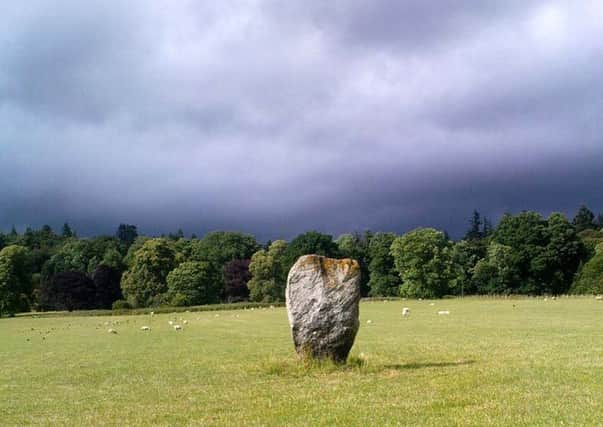6,000-year-old Highland stone felled by rain


The Dane’s Stone, also known as the Pitfourie Stone, is believed to have been a major feature of the landscape of Moulin, near Pitlochry in Highland Perthshire, since the Neolithic or Bronze Age.
But the standing stone, possibly once part of an ancient stone circle, has finally been felled after days of torrential rain.
Advertisement
Hide AdMarianne Carruthers, whose home overlooks the prehistoric stone, said she had been astounded when she looked out of a window and realised that the Dane’s Stone had disappeared from the landscape.
Mrs Carruthers, a pensioner who has lived in Moulin for more than 40 years, said the stone had toppled over last Wednesday after days of high winds and heavy rain.
She explained: “It was a particularly horrible day last Wednesday and the ground was very, very soft. I just heard this heavy thud and I thought at first it was a car door being closed and that was somebody was coming to visit me.
“But I could see the sheep going mad in the field and decided to move to a window where I could get a better look at the field and I couldn’t believe my eyes. I thought at first that the stone had shrunk. But I realised, after I had cleaned my specs, that I wasn’t seeing things and that the stone had toppled over. This big lump of quartzite had landed on the soft ground.”
Mrs Carruthers continued: “My younger son went out to have a closer look at the stone the day after it happened. We had always assumed it was like a tooth with long root because there used to be cows in that field that rubbed up against it and nothing happened.
“But he discovered that it had just been wedged into the ground with some stones and that there was little of the stone below the ground to start with. But it doesn’t seem to have been damaged in any way, as far as we know.”
Advertisement
Hide AdShe said added:”Lots of people have been up looking at it from Historic Scotland and things like that and it seems they have every intention of raising it. And that’s great because it is a feature of the village and we get quite lot of visitors during the year coming to see it. It’s amazing how many Scottish and foreign visitors come to see the stone.”
David Strachan, the manager of Perth and Kinross Heritage Trust, explained: “It is a prehistoric stone and probably dates back to between 4,000BC and 1,000BC. The name Dane’s Stone was probably given during the Middle Ages, around about the time of the Vikings.
Advertisement
Hide Ad“We don’t really know a huge amount about what these stones are for, but many do have ritual or religious significance.”
He said the Dane’s Stone was likely to have been used at the heart of funerals and burial ceremonies and described such structures as being “like churches” of ancient times.
Experts from Historic Scotland will now be assessing the damage and outlining plans to raise the megalith once again.
Erosion
Mr Strachan said the 7ft 3in tall stone probably weighed around one and half tonnes. And he continued: “Originally the stone would have been much more securely buried into the ground. Clearly throughout pre-history and since the Middle Ages, a combination of ploughing around the stone over hundreds of years and the movement of soil down the slope will have generally eroded the ground around the stone.
“It certainly wouldn’t have been put up like that by prehistoric peoples.”
He added: “Whenever we have dramatic episodes of weather like this, erosion is caused by water and historic sites are quite often dramatically affected by that.”
Advertisement
Hide AdMr Strachan said the toppling of the stone, however, would represent a rare opportunity to carry out a small excavation at the site to learn more about the history of the stone.
He added: “We would like to see the stone being re-erected because obviously it becomes an important historic landmark and offers a sense of character of place for the area.”